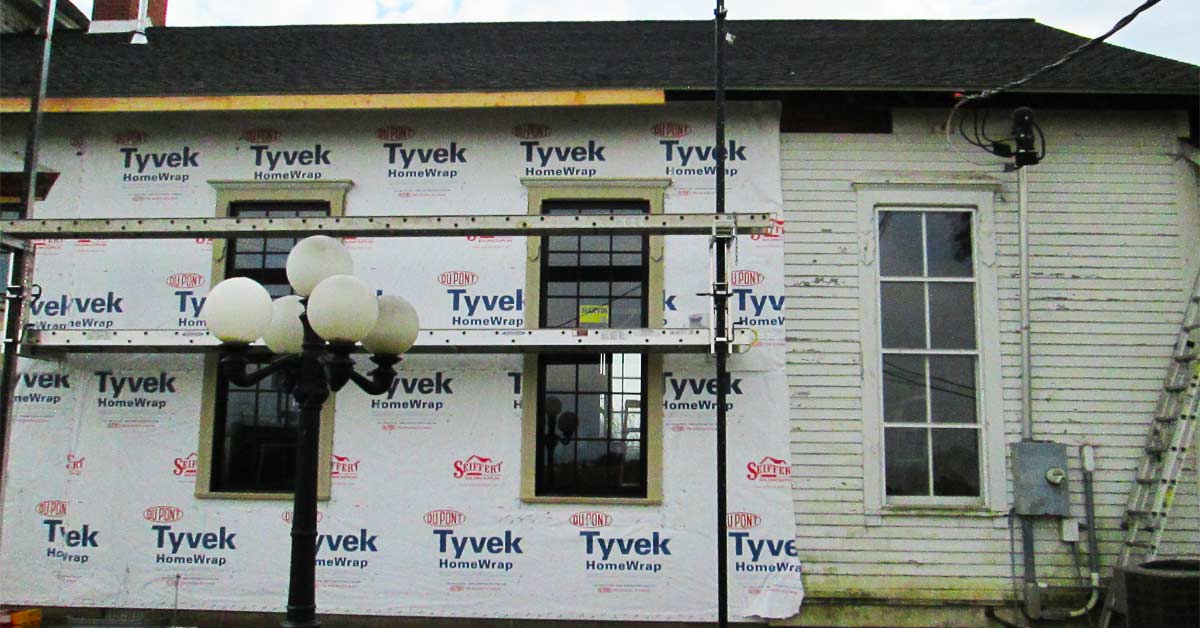
27 Apr House Wrap: The Ultimate Guide
When you’re building a home the process takes awhile. In our area we do have some crazy weather from time to time and the wind, rain, ice and snow we experience in the Quad Cities takes a toll on the structural integrity of the home even as construction takes place. You certainly don’t want water damage, rot or mold to build up within your homes structure.
Enter house wrap. Wrapping your house during construction keeps moisture at bay, pests from invading and shores up the overall integrity of your home’s structure. Let’s find out more about this nifty and quite essential product.
What Is House Wrap?
House wrap is not to be confused with insulation. Although it has insulating properties the main purpose of house wrap is to protect the insulation and prevent moisture from infiltrating your wall cavities. If moisture creeps and seeps into your wall cavities it can destroy your walls, studs and insulation. As a waterproof barrier against the elements it can also be a barrier against extreme temperatures when installed properly, but that is not the main job of house wrap.
In the 1970s house wrap became popular in building and construction. While wrapping a home to prevent issues during construction has been part the process for many decades prior to the 1970s it was then that plastic house wrap was introduced. The ease of installation, durability and successful waterproofing properties of plastic made house wrap the way to go.
Main Functions of House Wrapping Product
For house wrap to perform it’s job it must be impervious to both water and moisture. UV protection is another advantage your house wrap should have. Not only should this product protect your structure from weather damage but it should be durable enough to prevent its own degradation. This is especially useful in periods when construction is paused due to inclement weather.
Types of House Wrap
When it comes to wrapping your house against the elements you have some variety of products. There are also a few different terms such as “rain barrier” “rain screen” and “water-resistant barrier” but they all do the same job to different degrees. Here are a few types of house wrap:
- Asphalt Felt (tarpaper): A form of waterproofing that’s been around for a long time. Provides a barrier from rain and snow to protect the frame of the home.
- Grade D Building Paper: This type of house wrap is often used beneath stucco siding and is very similar to asphalt felt.
- Polyolefin Fabric: Plastic house wrapping material made of polyethylene or polypropylene fibers. Tyvek HomeWrap is a popular type of this wrap.
- Water Resistant Barrier Sheathing: This product is made from strand board and coated with a special material to make it water repellent.
- Rigid Foam Wrap: Builders apply rigid foam and then a sealant to create a water resistant barrier.
- Liquid Wrap: This is a tar-like substance which is rolled, sprayed or brushed directly onto the framework to create a moisture barrier.
How to Select The Proper Wrap for Your House
There are plenty of styles and brands of house wrap on the market and it can be overwhelming to find the one that’s right for you. At Seiffert Building Supplies we have knowledgeable professionals who are happy to help. Here are some of the properties to look for in a house wrapping product.
Water Resistance: This is the most basic function of any wrap for you home but many products don’t offer the best water resistance. House wrap must be put through three tests by the International Code Council Evaluation Services. They test for water ponding, humidity transfer and hydrostatic pressure. The test for humidity transfer is a very basic water resistance test. The better product will also have high scores in ponding and hydrostatic pressure as these tests qualify how much water is sheeted off the structure over a set period of time.
Durability: Depending on how long your home’s construction phase is the wrap you select is likely the only barrier between your home and the elements for possibly several weeks or months. Resistance to degradation of the wrap itself means it should be highly durable and stand up to UV rays, frigid air, weather extremes and freeze-resistant for 90-180 days.
Drainage: Since the wrap is protecting your structure from water it needs to be able to properly drain off any water that does get in. Think about some of the recent driving rains we’ve had in the Quad Cities. A great house wrap is one that drains efficiently, especially in volatile rainstorms.
Vapor Permeable: You should look for a house wrap that has a permeability range of 10-20 perms. The higher the perm rate the more easily vapors get into the house, so depending on your home’s location you may want to shoot for a lower perm rate. However, its important to note that permeability provides breathability for your home and releases water vapor.
Preserve Your Project and Protect Your Home
Every project is different and unique. But, whatever the project you need to protect your home from damage and degradation due to exposure to the elements. Preserve your homes integrity and prevent any interruptions to your timeline by using the proper house wrap for your construction project. For more information or help form our project support team please contact Seifert Building Supplies.

